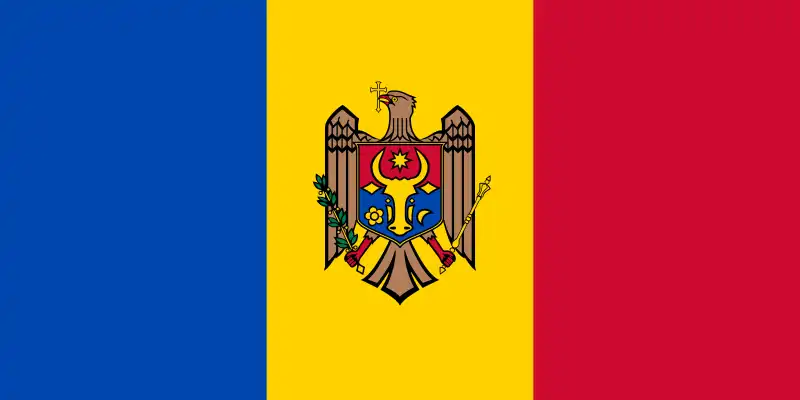Republic of Moldova - statistical data
The Republic of Moldova is a landlocked country located in Eastern Europe, bordered by Romania to the west and Ukraine to the north, east, and south. It has a total area of 33,846 square kilometers and is characterized by a diverse landscape of rolling hills, plains, and forests. The country's capital and largest city is Chisinau, situated in the central region of the country.
With a population of approximately 2.6 million people, Moldova is one of the least populous countries in Europe. The majority of the population is ethnically Moldovan, with significant minorities of Ukrainians, Russians, and Gagauz. The country has a relatively low population density, with most people living in rural areas and small towns. Moldova has a predominantly agricultural economy.
Land of Republic of Moldova
The Republic of Moldova is a land of rich cultural heritage and natural beauty. With a history dating back thousands of years, this country has been shaped by various civilizations and influences. From ancient archaeological sites to medieval fortresses and churches, Moldova is a treasure trove of historical landmarks.
In addition to its cultural significance, Moldova is also known for its stunning landscapes. The country boasts lush vineyards, rolling hills, and picturesque countryside. With a temperate climate and fertile soil, Moldova is a paradise for agriculture.
Overall, the Republic of Moldova offers a unique blend of history, culture, and natural beauty. Visitors to this country can explore its rich heritage, and enjoy the peaceful countryside. Moldova truly is a hidden gem waiting to be discovered.
Climate of Republic of Moldova
The climate of the Republic of Moldova is characterized by a temperate continental climate with hot summers and cold winters. The country experiences four distinct seasons, with a significant variation in temperature throughout the year.
During the summer months, temperatures can reach up to 30 degrees Celsius, with July and August being the hottest months. In contrast, winter temperatures can drop below freezing, with January and February being the coldest months. Snowfall is common during the winter months, adding to the picturesque landscapes of the country.
The climate of the Republic of Moldova is influenced by its geographical location and proximity to the Black Sea. The country is also affected by weather patterns from both the Atlantic Ocean and the Eurasian landmass. These factors contribute to the variability in temperature and precipitation levels experienced throughout the year. Overall, the climate of the Republic of Moldova plays a significant role in shaping the country's natural landscapes and agricultural practices.
Languages of Republic of Moldova
The Republic of Moldova is a multilingual country with several languages spoken by its diverse population. The official language of Moldova is Moldovan, which is a dialect of Romanian. This language is spoken by the majority of the population and is used in government, media, and education. Russian is also widely spoken in Moldova, especially in urban areas and among the older population. In addition to Moldovan and Russian, Gagauz, Ukrainian, and Bulgarian are recognized as regional languages in certain parts of the country.
The linguistic diversity of Moldova reflects its complex history and cultural heritage. The country's location at the crossroads of Eastern Europe has influenced the languages spoken in the region. Moldova's diverse population includes ethnic Moldovans, Ukrainians, Russians, Gagauz, Bulgarians, and other minority groups, each with their own language and cultural traditions. This linguistic diversity is a source of pride for many Moldovans and contributes to the rich tapestry of the country's cultural identity. Overall, the languages of Moldova play a crucial role in shaping the country's social, political, and cultural landscape.
Demographic trends
The Republic of Moldova is experiencing significant demographic trends that are shaping the country's population dynamics. One of the key trends is the aging population, with a growing number of elderly individuals compared to the younger population. This demographic shift is a result of declining birth rates and emigration of younger individuals in search of better opportunities abroad. As a result, the dependency ratio is increasing, putting pressure on the working-age population to support the elderly.
Another important demographic trend in the Republic of Moldova is urbanization, with more people moving from rural areas to urban centers in search of employment and better living conditions. This trend is leading to rapid urban growth and infrastructure development in cities, while rural areas are experiencing depopulation and declining economic activity. The urban-rural divide is widening, posing challenges for policymakers in ensuring balanced regional development and addressing disparities in access to services and opportunities.
Overall, these demographic trends in the Republic of Moldova have implications for various aspects of society, including healthcare, social welfare, and economic development. Understanding and responding to these trends is essential for policymakers to effectively plan for the future and ensure sustainable growth and well-being for all segments of the population.
Republic of Moldova interesting facts
The Republic of Moldova is a country with a rich history and a unique culture.
Another fascinating aspect of Moldova is its diverse population, with a mix of Romanian, Ukrainian, Russian, and Gagauz influences. This cultural diversity is reflected in the country's cuisine, music, and traditions. Moldova is also known for its traditional handicrafts, such as pottery, embroidery, and weaving, which have been passed down through generations.
In addition to its cultural heritage, Moldova is also a country of natural beauty, with picturesque landscapes, including rolling hills, lush forests, and meandering rivers. The country is home to several national parks and nature reserves, which are popular destinations for hiking, birdwatching, and wildlife spotting. Overall, Moldova is a country with a rich tapestry of history, culture, and natural wonders waiting to be explored.
